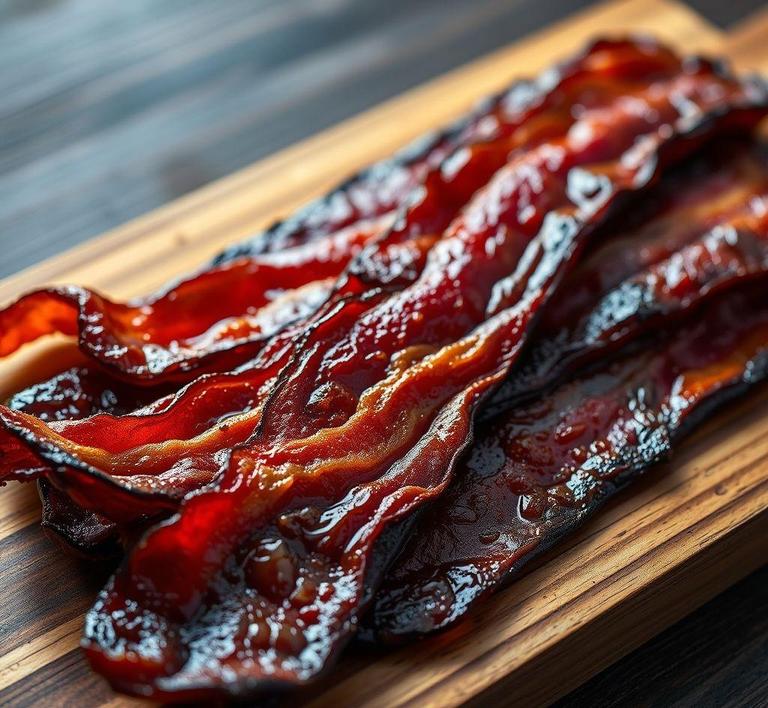So, you’ve got some leftover bacon and are wondering if you can refreeze it for later? You’re not alone! Refreezing bacon can be a convenient way to reduce waste and make sure it doesn’t go bad. While it’s totally possible to refreeze bacon, there are a few things you’ll want to keep in mind to make sure it stays tasty and safe to eat. In this guide, we’ll walk you through the best practices for refreezing bacon, how to store it properly, and what to expect when you thaw it out again. So, whether you’re trying to extend the life of your bacon or just need to plan ahead for future meals, keep reading to get all the info you need!
Can You Refreeze Bacon?

Bacon is one of those ingredients that holds a special place in many kitchens, loved for its crispiness, savory flavor, and versatility. But if you’ve ever found yourself with leftover bacon after a cooking session, you may have wondered: Can you refreeze bacon? The short answer is yes, but there are some key considerations to keep in mind before deciding to pop it back in the freezer.
Bacon, like most perishable meats, can technically be refrozen after it has been thawed. However, the process comes with some important guidelines and caveats. The USDA’s general rule of thumb states that food can be refrozen if it has been thawed in the refrigerator and hasn’t been out at room temperature for more than two hours. This is crucial to avoid the growth of harmful bacteria, which is especially important with fatty cuts like bacon.
However, it’s not just about safety. Refreezing bacon can be a double-edged sword. While you can safely refreeze it under the right conditions, the quality of the bacon could be compromised, and that’s what we’ll dive into in the next section.
How To Refreeze Bacon?
Refreezing bacon is a relatively simple process, but there are steps you should follow to ensure that you maintain as much of the bacon’s quality as possible. The key is to prevent the bacon from being exposed to air or moisture during the freezing process, as both can lead to freezer burn and a loss of texture and flavor.
-
Thawing Bacon Properly
If your bacon is frozen and you’re planning to thaw it before refreezing, always do so in the refrigerator. Thawing bacon at room temperature can encourage bacterial growth, which is unsafe. If you’re using pre-cooked bacon, consider microwaving it and using it immediately rather than refreezing.
-
Wrap It Well
When refreezing raw bacon, wrap it tightly in plastic wrap, aluminum foil, or a freezer-safe bag. For even better results, you can place the wrapped bacon in an airtight container or another layer of plastic to further reduce the risk of air exposure. If you’re planning on using only portions of bacon at a time, consider dividing it into smaller packets. This allows you to only thaw what you need, without having to deal with refreezing multiple times.
-
Label and Date
To ensure you’re using your bacon within a safe timeframe, label each package with the date it was frozen. Bacon can last up to 6 months in the freezer if properly stored, though it’s best to consume it sooner to maintain optimal flavor and texture.
-
Quick Freeze for Better Results
If you have space in your freezer, try freezing the bacon on a baking sheet in a single layer before placing it into a bag. This quick-freezing technique ensures the slices don’t stick together, making it easier to take out just the amount you need. This method also helps preserve texture and ensures a more even freezing process.
Quality Impact
Refreezing bacon does come with some trade-offs, particularly in terms of quality. The most noticeable impact is on texture and flavor. Bacon’s high-fat content makes it more prone to becoming rubbery and losing its crispness after being frozen and thawed. Here’s what you might experience when you refreeze bacon:
-
Loss of Crispiness
One of bacon’s signature qualities is its crispy texture. After refreezing and then reheating it, the bacon may lose some of that satisfying crispiness and turn out a bit chewier or soggy. The moisture released during thawing can cause the bacon to soften, even when cooked again.
-
Flavor Deterioration
While bacon’s distinctive smoky and savory flavors can hold up fairly well through freezing and thawing, repeated cycles of freezing and thawing can degrade the taste over time. Freezer burn, which occurs when food is exposed to air and moisture in the freezer, can also result in off flavors. Bacon that has been refrozen may not taste as fresh or as flavorful as when it was first frozen.
-
Increased Risk of Dryness
Freezing and thawing bacon can lead to the loss of moisture. As it is exposed to air in the freezer or thawing process, the fat can solidify, causing the bacon to dry out when cooked. This results in less juicy, less tender bacon, which can be a disappointment, especially for those who enjoy it soft and succulent.
-
Texture Changes
Bacon that has been refrozen may also experience a change in texture. While freshly cooked bacon has a smooth, tender bite, refrozen bacon can become a bit rubbery or uneven in texture. This is particularly true if the bacon was not wrapped or stored properly, as the fat can leach out during freezing.
Refreezing bacon is certainly possible, but it’s a practice that should be approached with caution if you want to preserve its original quality. While it’s safe to refreeze bacon if it’s been thawed in the fridge and handled properly, you can expect some loss in texture, flavor, and overall quality. The fat in bacon, which is responsible for its crispiness and rich taste, can suffer during the freezing process. For those who prioritize taste and texture, using fresh bacon or consuming it within a few days after thawing might be the better option.
However, if you find yourself with excess bacon or need to extend its shelf life, refreezing is an effective way to avoid waste. Just make sure to store it properly in airtight packaging, and be mindful that the bacon might not have quite the same appeal after being refrozen. When in doubt, cook the bacon right away, or if you do refreeze, try to use it within a few months to enjoy the best possible flavor and texture.
Is It Safe To Refreeze Bacon?
Refreezing bacon, like many other foods, is a practice that often comes with a lot of questions and concerns about food safety. In general, it’s technically safe to refreeze bacon if it has been thawed properly, but there are some important guidelines to follow to ensure it remains safe to eat and maintains its best quality.
When bacon is frozen, the cold temperature halts bacterial growth, so it can be safely stored for long periods without spoiling. The primary issue when refreezing bacon is its quality-freezing and thawing can alter the texture and flavor, especially if it’s not handled properly. If you thaw bacon in the fridge, meaning it doesn’t sit out at room temperature for long periods, you can refreeze it, but with a decrease in quality. The moisture released during the thawing process is what causes bacon to lose some of its crispiness and flavor when refrozen, so it’s important to consider this trade-off.
The major risk associated with refreezing bacon is improper handling. If bacon is thawed at room temperature for longer than two hours, bacteria can begin to multiply. Refreezing bacon after it has reached this ‘danger zone’ will not destroy the bacteria and could result in foodborne illness. To refreeze bacon safely, it should be thawed in the refrigerator (and not on the counter), ensuring that it remains at a safe temperature (below 40°F or 4°C).
Signs That Bacon Should Not Be Refrozen
There are clear signs that bacon should not be refrozen, and these can be based on both its appearance and handling. These warning signs are crucial to recognize to avoid potential health risks.
- Off-Scent or Rancid Smell: Bacon that has gone bad will emit a strong, unpleasant odor that is much different from its usual smokey scent. If the bacon smells sour or rancid, it’s no longer safe to eat, and definitely shouldn’t be refrozen.
- Discoloration: Fresh bacon has a distinct pink or red color, often with a little bit of marbling. If bacon turns grayish or brown, or if you notice any greenish tinge, this could be a sign of spoilage. Freezing bacon that is already showing these signs will result in unpleasant texture and taste when it’s cooked.
- Slimy or Sticky Texture: Bacon should have a firm, slightly greasy texture, but it should never feel slimy. If it’s overly wet, slimy, or sticky to the touch, it has likely been improperly stored or thawed too long and should not be refrozen.
- Thawing Outside the Refrigerator: If bacon has been left out on the counter to thaw at room temperature for more than two hours, bacteria may have started to grow, making it unsafe to refreeze. The risk increases if bacon has been left out for longer periods, as bacteria such as Salmonella or Listeria can thrive in this temperature range.
- Freezer Burn: If your bacon has been frozen for too long and shows signs of freezer burn-like discolored patches or a dry, leathery texture-refreezing it will likely result in poor quality. Freezer-burned bacon won’t harm you, but it will be tough, dry, and flavorless.
Common Refreezing Mistakes
Refreezing bacon may seem simple, but there are several common mistakes that can jeopardize both the safety and quality of your bacon.
- Thawing Bacon on the Counter: One of the biggest mistakes people make is thawing bacon at room temperature, which can lead to bacterial growth. This is especially problematic if you plan to refreeze it because bacteria are not killed by freezing, and they can continue to multiply when the bacon is thawed again. Always thaw bacon in the refrigerator to maintain a safe temperature.
- Not Using Airtight Packaging: Freezer burn is the result of air coming into contact with the food. When refreezing bacon, it’s essential to wrap it properly in airtight packaging, such as heavy-duty freezer bags or vacuum-sealed bags. If the bacon is left exposed to air, it will lose its quality and become dry and tough.
- Repeated Freezing and Thawing: Bacon, like other meats, should not be repeatedly frozen and thawed. Each time it is thawed, its texture changes, and it loses moisture, leading to a deteriorated product. If you plan to use a portion of your bacon, only thaw the amount you intend to eat and keep the rest frozen.
- Freezing Bacon with Too Much Liquid: After bacon is thawed, it tends to release some moisture. If you’re not careful, this excess moisture can accumulate in your packaging and result in soggy bacon when refrozen. Be sure to drain any excess liquid before packaging it for refreezing.
- Freezing Bacon for Too Long: While bacon can be stored in the freezer for several months, refreezing it after long periods can affect its taste and texture. If the bacon has been in the freezer for an extended time (more than six months), it’s a good idea to check it carefully for signs of freezer burn or deterioration before deciding to refreeze it.
Tips And Tricks
To make the most of your bacon while minimizing waste, here are a few tips and tricks for freezing, thawing, and refreezing bacon:
- Pre-portion and Freeze in Small Quantities: If you’re unsure whether you’ll use the whole pack of bacon at once, consider slicing it into individual portions before freezing. This way, you can defrost only the amount you need without having to refreeze the entire package.
- Use Wax Paper or Parchment Paper: When separating bacon slices before freezing, use wax paper or parchment paper between the slices. This prevents them from sticking together and allows you to pull out a slice or two without defrosting the whole batch.
- Label Your Packages: It’s important to label your bacon packages with the date they were frozen. This helps you keep track of how long the bacon has been stored, so you can use the oldest packages first and avoid keeping bacon in the freezer for too long.
- Thawing Methods: Thaw bacon in the refrigerator for at least 24 hours to ensure that it remains at a safe temperature. If you’re in a rush, you can thaw bacon in cold water, but never use hot water to speed up the process, as this can increase the risk of bacterial growth.
- Cook Before Refreezing: Another great way to extend the life of your bacon is by cooking it before freezing. Once cooked, bacon can be frozen without compromising its flavor or texture nearly as much as raw bacon. You can freeze cooked bacon and then thaw it later, reheating it in a skillet or microwave for a quick and easy meal.
Conclusion
Refreezing bacon is safe if done with care, but it does come with some risks. If the bacon has been properly thawed in the fridge and handled safely, it’s safe to refreeze, though the quality may suffer. Keeping an eye out for signs of spoilage, such as off-smells, discoloration, or a slimy texture, is essential to ensuring that the bacon remains safe to eat.
Avoid common mistakes like thawing on the counter, not using airtight packaging, or refreezing multiple times, as these can lead to both safety concerns and poor texture or taste. By following a few simple tips and tricks-like pre-portioning bacon, using proper packaging, and labeling your frozen goods-you can make the most of your bacon stash and avoid unnecessary waste.
While refreezing bacon is possible, remember that fresh is always best. If you’re planning to use bacon in multiple meals, it’s better to freeze it in smaller portions to maintain the highest quality and ensure that you’re only thawing what you need. With a little planning and care, you can keep your bacon fresh and safe to eat, whether it’s cooked or raw, frozen or refrozen.


